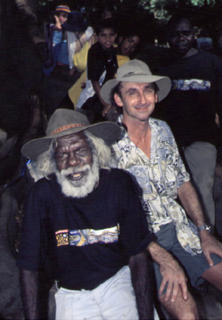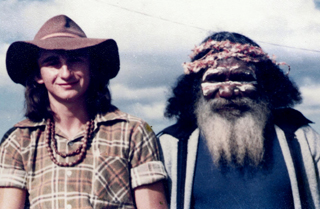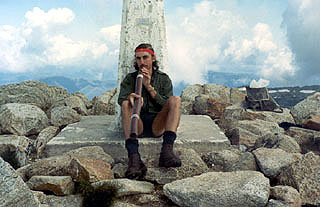|
Warning:
Some of these pages may contain referrence to, and images
of Aboriginal people that are now deceased. Please be careful
to avoid causing distress to traditional people whom may be
offended or hurt by viewing these pages by forewarning them
of their content. Thankyou.
My
Didjeridu Background
I started trying
to make sounds on a piece of plastic electrical conduit from
a neighbour's building site back in 1970. I may have been
inspired by Rolf Harris and David
Blanasi at the time - it's all too far back and misty.
Harris had a TV programme that showcased the 'outback', and
with his naturalist friends, Vincent Serventy and Harry Butler,
they travelled the country, visiting Aboriginal communities
along the way. Harris often had Blanasi on the show and there
was regular didj playing segments.
 |
David
Blanasi and myself at Womadelaide (WOMAD Festival, Adelaide,
SA) 2001 |
I
had a hard time learning to play - I was in Sydney - far
removed from the Top End, the traditional home of the didjeridu
and I was only 10. My patience was limited. I'd come home
from school and make droning noises on my bit of plastic,
but I couldn't work out how to breathe in and out at the
same time. Eight years later, I'd figured it out.......I
decided I had to store air in my cheeks and expel it while
I took a breath in through my nose. I did it!! Much to my
disappointment, I couldn't get the same sounds out of my
'instrument' as what I was hearing on the old recordings
I had from Arnhem Land.
So I went and purchased
the only instrument I'd seen in Sydney outside of the Museum.
It was in the window of the Bush Church Aid Society shop in
Bathurst St. in the heart of the city. I had no idea what
it would sound like - all I knew was that it was a real didjeridu,
and it was from Mornington Island, and that's all that mattered.
It seemed a longer than usual trip home on the bus and I received
some strange looks, standing in the bus aisle with a long
brown paper parcel. I was eager to hear how it sounded. About
a mile's walk from the bus stop to home, and I finally was
able to unwrap it and give it a go. It took so much air!!!!
I couldn't believe it. How was I ever going to be able to
breathe with this thing?. It seemed a big jump from 3/4" conduit
to the genuine thing. Well I finally managed it and I just
couldn't stop playing that thing. My diaphragm ached and I
split my lip. That was 1978. I still have that stick, it's
the one on the right in the image
below. I was still unhappy with the sound though - it just
wasn't the same as in the recordings I had. I decided it must
have been the instrument, but with experience I found that
was not the only difference. It was obvious that there were
set rhythms for songs and that particular notes alterred with
the taking of a breath (when I did it). The sound changed
dramatically when I took a breath because I was using my cheeks
and if I tried to play a traditional piece, I couldn't get
it right, because my breathing was wrong. There had to be
a way of taking a breath without using my cheeks. I worked
on this until I found I could breathe without using my cheeks
as a reservoir, but it was so tiring that I ultimately returned
to playing with my cheeks.
Around that same
time the Aboriginal Arts Board of Australia Council and various
other groups like the Aboriginal Artists Agency started bringing
traditional people down from the Top End to perform in Sydney.
One of the very first recordings I'd bought was a solo
didjeridu recording - the first of its' kind, by a renowned
clan leader and artist of northeastern Arnhem Land, the late,
renowned Wandjuk Marika. I was fortunate in being able to
meet him and various performers from Elcho Island on several
occasions.

Wandjuk Marika and myself, 1980
|
|
|
In
1980 I purchased another instrument. I was in Alice
Springs at the time and made my selection from about
fifty others in the Aboriginal Arts & Crafts Pty
Ltd shop, now the Aboriginal
Art & Culture Centre. It had been made in Arnhem
Land, but had no documentation with it. It's the one
second from the left in the image. |
In
those days, didjeridu's were ONLY made in the Top End, now
they're made all over the country and from a wider variety
of eucalypt species. I have since aquired a few more traditional
pieces, from various other parts of Arnhem
Land such as Yirrkala, Dhalinbuy, Ramingining.
I found some old
photos of me - always good for a laugh !!
|
|
Around
a campfire at Uluru (Ayer's Rock) NT, May 1980.
Playing someone elses instrument. |
|
Playing on our highest peak, Mt Kosciusko,
southern highlands, NSW, late in 1980 I think. This
was my first instrument mentioned above - from Mornington
Island. |
 |
|
|
|
....with some Aboriginal boys, Maroota,
NSW 1981. |
|
....and a press photo from when I was working for
the NSW National Parks & Wildlife Service, Hartley
Historic Site, Blue Mountains, NSW, August 1981.
The instrument in both black & white photos
is the one purchased in the Alice in 1980. |
|
|
I saw something
of a commodification of the instrument during the late 1980's,
and suddenly everyone was playing. I guess the main thing
that turned me off playing was other peoples' interpretation
of why I played. I didn't carry the instrument about as if
I were advertising my skill (in fact, if I took it somewhere
it was in a soft cloth case and most folk thought I was going
fishing)- but people who found through others that I could
play would ask me to play for them. I was young and naive
and never said no to anyone. So I would play for them. Before
I knew it, there was a barage of ridiculous questions about
how I'd learnt. "Was I part aboriginal ?" or "Had
I been initiated ?".....I couldn't believe it, and so
after a while I grew away from playing. Unfortunately, Australians
are still this ignorant of the didjeridu and Aboriginal cultures
generally.
For a more detailed
run down on my background, you can also checkout an interview
I did with Ed Drury in the States for his Portland Area Didjeridu
Player Newsletter.
|

